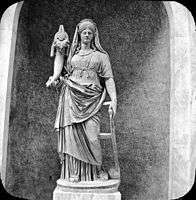Gubernaculum (classical)
A gubernaculum in classical references describes a ship's rudder[1] or steering oar.[2] Gubernaculum, like cornucopia, is really a Latin word.[3] The English word government[4] is related to it. The Old English word governail[5] and the Scots word gouernaill[6] are both derived from it.
Classical history
The ancient rudder's different parts were distinguished by the following names: ansa, the handle; clavus, the shaft; pinna, the blade.[7] The famous ship Tessarakonteres or "Forty" is said to have had four rudders. In the Bible, Paul's ship, which was shipwrecked on Malta, had its rudders (plural)[8] cut loose.[9]
Classical depiction
Various gods such as Tritons and Venus have been shown with a gubernaculum.[10] It is most associated with Fortuna since, along with the cornucopia, it is an item that she is often depicted as holding. The corresponding Greek god Tyche is also regularly shown with a gubernaculum. There are abundant depictions of Fortuna holding the gubernaculum on coins, in paintings, on altars and statues or statuettes.
Fortuna is depicted on around 1000[11] different Roman coins usually holding a gubernaculum.[12]
A sandstone statuette of Fortuna[13], the Roman god of luck, fate, fortune[14] was found at Castlecary and can now be found at the Hunterian Museum in Glasgow, Scotland.[15]
 Dupondius Fortuna with gubernaculum
Dupondius Fortuna with gubernaculum
 Statuette[16] of the Roman god Fortuna, with gubernaculum (ship's rudder)[17], Rota Fortunae (wheel of fortune) and cornucopia (horn of plenty) found near the altar at Castlecary in 1771.[18]
Statuette[16] of the Roman god Fortuna, with gubernaculum (ship's rudder)[17], Rota Fortunae (wheel of fortune) and cornucopia (horn of plenty) found near the altar at Castlecary in 1771.[18]
Symbolism and meaning
In mythology the rudder, which the goddess can steer, represents control of the changeable fortunes of life. Plato used the metaphor of turning the Ship of State with a rudder. In the Biblical book of James, the author compares the tongue with a ship's rudder which, though physically small, makes great boasts.[19]
References
- "Gubernaculum from Dictionary of Roman Coins". Forum Ancient Coins. The Collaborative Numismatics Project. Retrieved 12 October 2017.
- Hill, George Francis, Sir (1903). Illustrations of school classics, arranged and described. London: Macmillan. Retrieved 13 October 2017.
- Mollett, John William (1883). An illustrated dictionary of words used in art and archaeology. Explaining terms frequently used in works on architecture, arms, bronzes, Christian art, colour, costume, decoration, devices, emblems, heraldry, lace, personal ornaments, pottery, painting, sculpture, &c., with their derivations. London: S. Low, Marston, Searle and Rivington. p. 162. Retrieved 13 October 2017.
- Matthews, John. "Sir Gawain: Knight of the Goddess". google books. Retrieved 14 October 2017.
- Dwight, William (1889–1891). The Century dictionary: an encyclopedic lexicon of the English language: prepared under the superintendence of William Dwight Whitney. New York: Century Co. p. 2585. Retrieved 13 October 2017.
- Francisque, Michel (1882). A critical inquiry into the Scottish language with the view of illustrating the rise and progress of civilisation in Scotland. Edinburgh: W. Blackwood. p. 364. Retrieved 13 October 2017.
- Peck, Harry Thurston (1896). Harper's dictionary of classical literature and antiquities. New York: Harper & brothers. p. 754. Retrieved 13 October 2017.
- Conybeare, William John; Howson, John Saul (1861). The life and epistles of St. Paul. London: Longman, Green, Longman, and Roberts. p. 371. Retrieved 13 October 2017.
- "The Shipwreck on Malta". Bible Gateway. Retrieved 13 October 2017.
- Smith, William (1859). A Dictionary of Greek and Roman Antiquities. Little, Brown, and Co. pp. 788–789. Retrieved 13 October 2017.
- "Fortuna Coins". Online Coins of the Roman Empire (OCRE). American Numismatic Society and the Institute for the Study of the Ancient World at New York University. Retrieved 12 October 2017.
- "Late Roman Coins with Fortuna, from the period of the first tetrarchy at the end of the third century AD". Ancient Roman and Greek Coins: Educational pages. Retrieved 12 October 2017.
- "Fortuna". The Magical Art of Thalia Took. Retrieved 12 October 2017.
- "Fortuna & The Wheel of Fortune". Exploratory Shakespeare. Retrieved 12 October 2017.
- "The Antonine Wall: Rome's Final Frontier". The Hunterian. University of Glasgow. Retrieved 10 October 2017.
- "statuette of Fortuna". Hunterian Museum & Art Gallery Collections: GLAHM F.43. University of Glasgow. Archived from the original on 13 October 2017. Retrieved 13 October 2017.
- "Roman statuette of Fortuna". BBC - A History of the World. Retrieved 12 October 2017.
- MacDonald, James (1897). Tituli Hunteriani: An Account of the Roman Stones in the Hunterian Museum, University of Glasgow. Glasgow: T. & R. Annan & Sons. pp. 90–91. Retrieved 11 October 2017.
- "Taming the Tongue". Bible Gateway. Retrieved 9 November 2017.